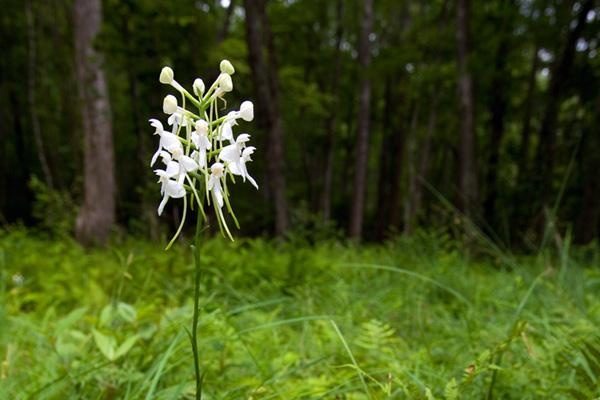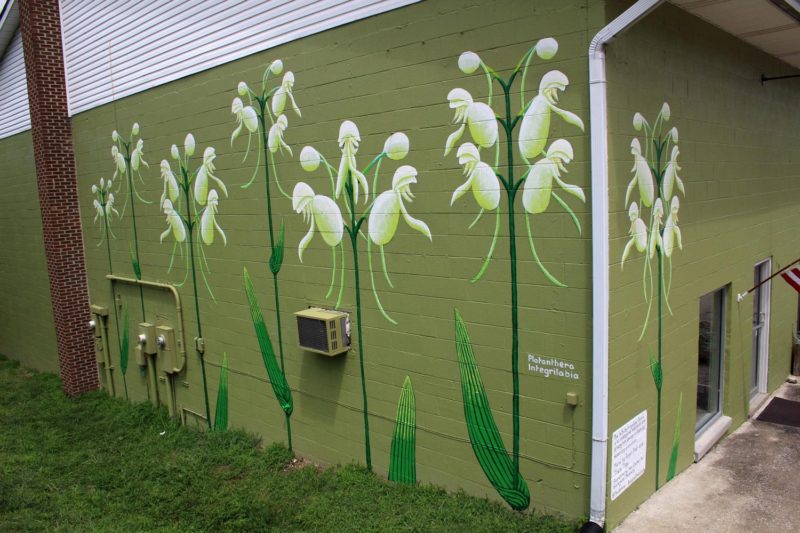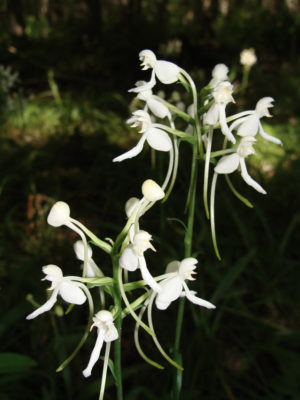
The role of artists in protecting endangered species
Artist Roger Peet of Portland, Oregon sees the role of the artist as one who raises public awareness to the point of action in protecting the environment. To that end he has painted a series of murals depicting various endangered species. The murals are situated in parts of the country where these species live, and where they are endangered. In Peet’s own words,
These murals are imagined as tools to help celebrate local endangered species within communities, and to encourage people to make connections between conservation and community strength.
His work is part of the Endangered Species Mural Project, sponsored by the Center for Biological Diversity.
One of Peet’s murals depicts Platanthera integrilabia, the white fringeless orchid, known to exist in six southeastern states of the U.S. — Alabama, Georgia, Kentucky, Mississippi, South Carolina, and Tennessee. The Platanthera intergrilabia was identified in 1975 as needing federal protection and placed under the classification “Candidate”. Finally, just this month, it received protection under the Endangered Species Act.
The Center For Biological Diversity, in a September, 2016 press release states:
The white fringeless orchid grows in the wet soils of bogs, marshes, fens and swamps. It’s pollinated by butterflies, including eastern tiger swallowtails, spicebush swallowtails and silver-spotted skippers. Because of these very specific relationships, it is threatened by global climate change, which, in addition to threatening its habitat with drought, poses threats to the fungus and pollinators the orchid depends on for survival.
The orchid is also threatened by logging — primarily conversion of native hardwood forests to monoculture pine plantations. Other threats include sprawl, mowing and herbicide spraying on right-of-ways, wetland draining, invasive plants nd feral hogs.
“I’m breathing a sigh of relief that this beautiful flower has finally gained Endangered Species Act protection after a 41-year wait,” says Tierra Curry, a senior scientist at the Center. “Protecting the white fringeless orchid will also protect the threatened marshy habitats that are such a special part of the Southeast’s natural heritage.
Orchids of North America are subject of Smithsonian research
To find out more about this orchid, I went to Go Orchids, the website produced by the Smithsonian’s North American Orchid Conservation Center. The Smithsonian also included Texas, in addition to the six  southern states listed above, as part of this orchid’s habitat. The website describes the appearance of the orchid, and also how its name relates to the physical characteristics.
southern states listed above, as part of this orchid’s habitat. The website describes the appearance of the orchid, and also how its name relates to the physical characteristics.
The labellum is entire (lacks any fringing) and a noticeable, elongated spur extends from the back of the flower and curves slightly forward. The flowers are usually sweetly scented at night. It can be distinguished from other Platanthera species by its white flowers and the absence of any fringing on the labellum.
Roger Peet’s murals have helped to raise the consciousness of the public, and may have been a factor in raising the Platanthera inergrilabia from “candidate” to “endangered”, thus increasing the protection it has. In his own way, Mr. Peet’s murals could very well be a force in determining whether this orchid species ultimately survives.
Artists have always played an important role in raising public awareness
All throughout history artists have made the public aware of wrongs that needed to be set right. As far back as the days of Aristotle art was recognized as an important vehicle for delivering social messages. Aristotle spoke of it in ancient Greece, as did many other philosophers. In more modern times we need look no further than at the powerful imagery of Picasso’s Guernica,  which so completely encapsulates the horrors of the Spanish Civil War. Having once seen this painting, it is impossible to forget. The old saying, “A picture is worth a thousand words” has never been more true.
which so completely encapsulates the horrors of the Spanish Civil War. Having once seen this painting, it is impossible to forget. The old saying, “A picture is worth a thousand words” has never been more true.
That old saying is still true today. As we face the challenges confronting our world artists once again play an important role in helping us to see more clearly. A case in point is the issue of conservation. It all begins with creating public awareness. Only the knowledge and passion of the public can create enough impetus to make laws and put in place the mechanisms necessary to protect our Earth.
Note: The Center for Biological Diversity is a national, nonprofit conservation organization with more than 1.1 million members and online activists dedicated to the protection of endangered species and wild places. ![]()